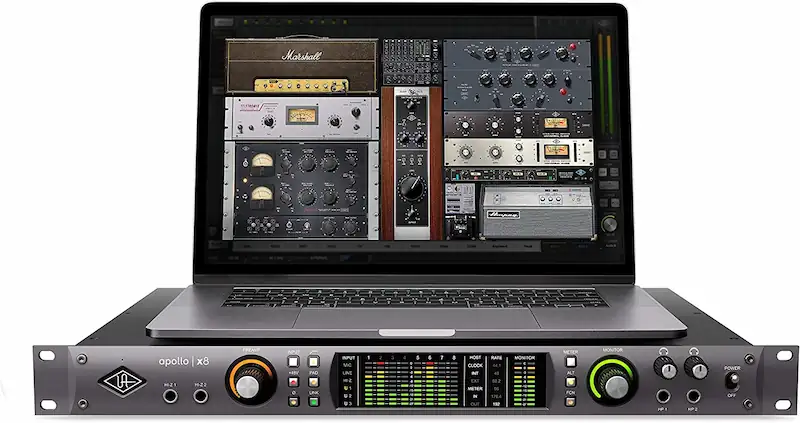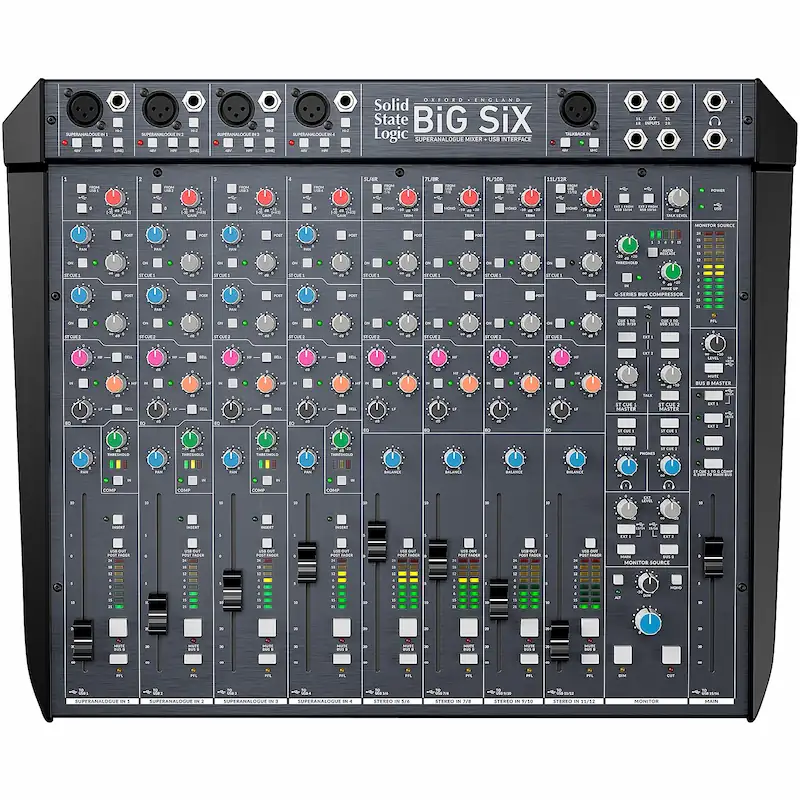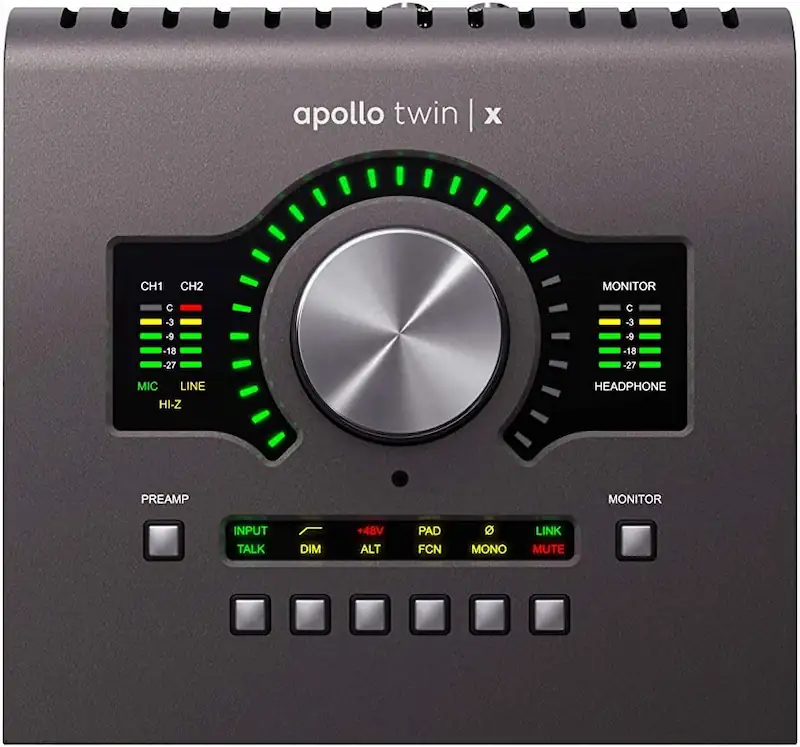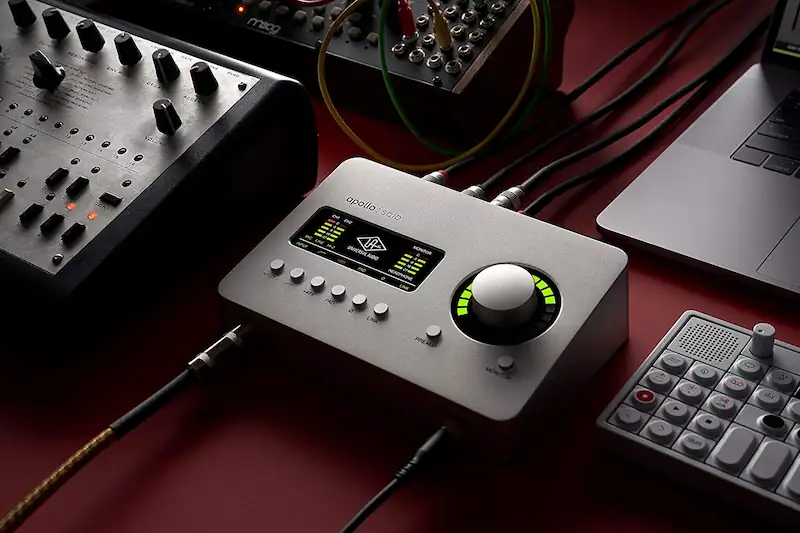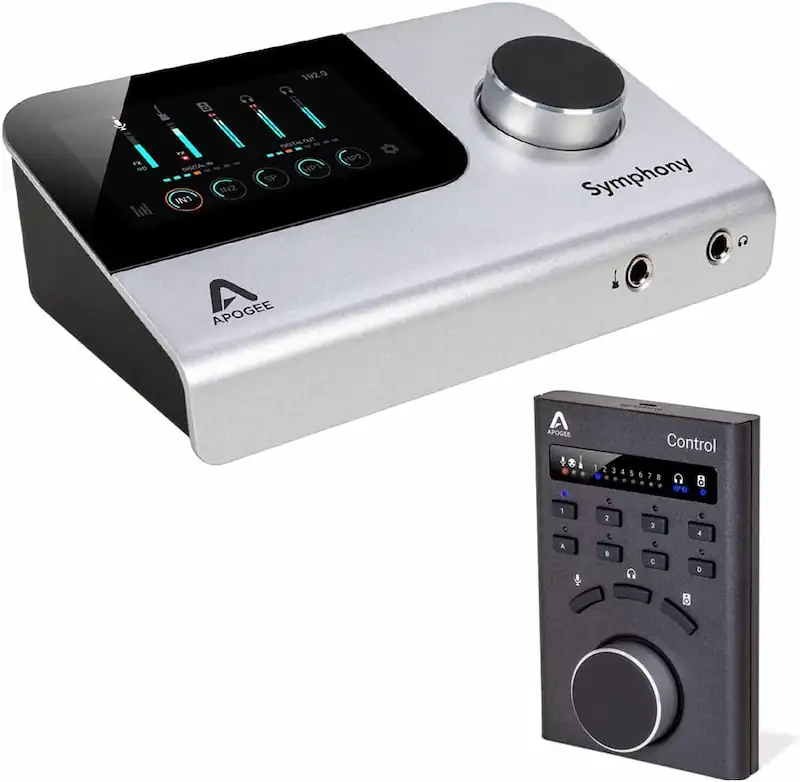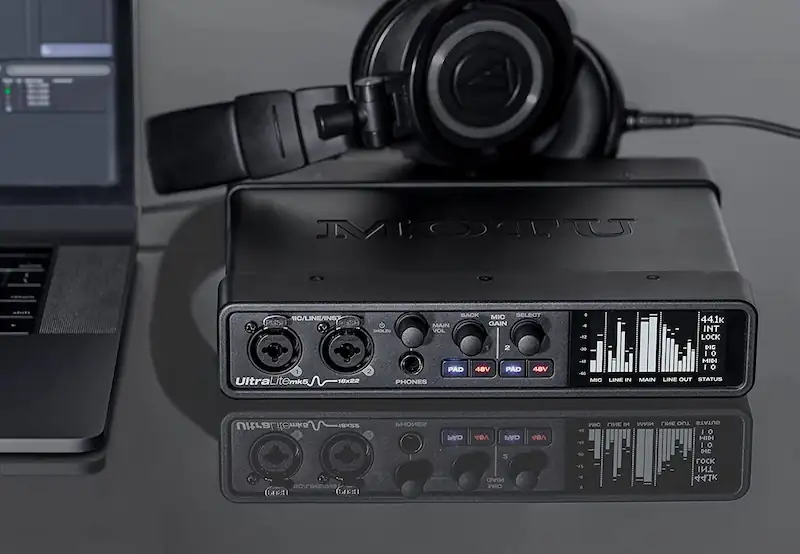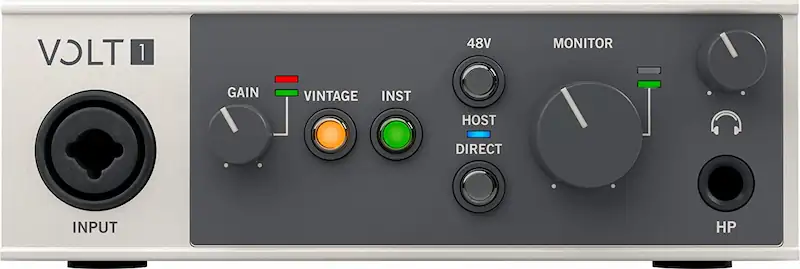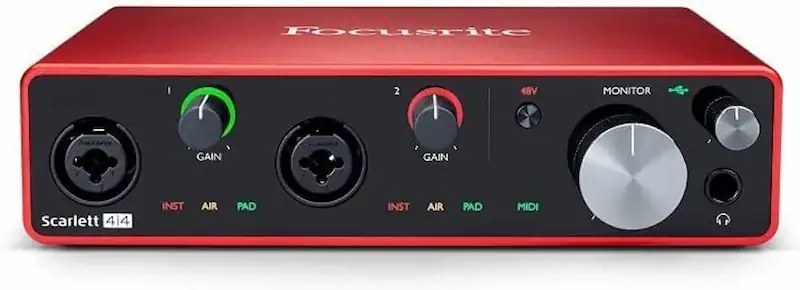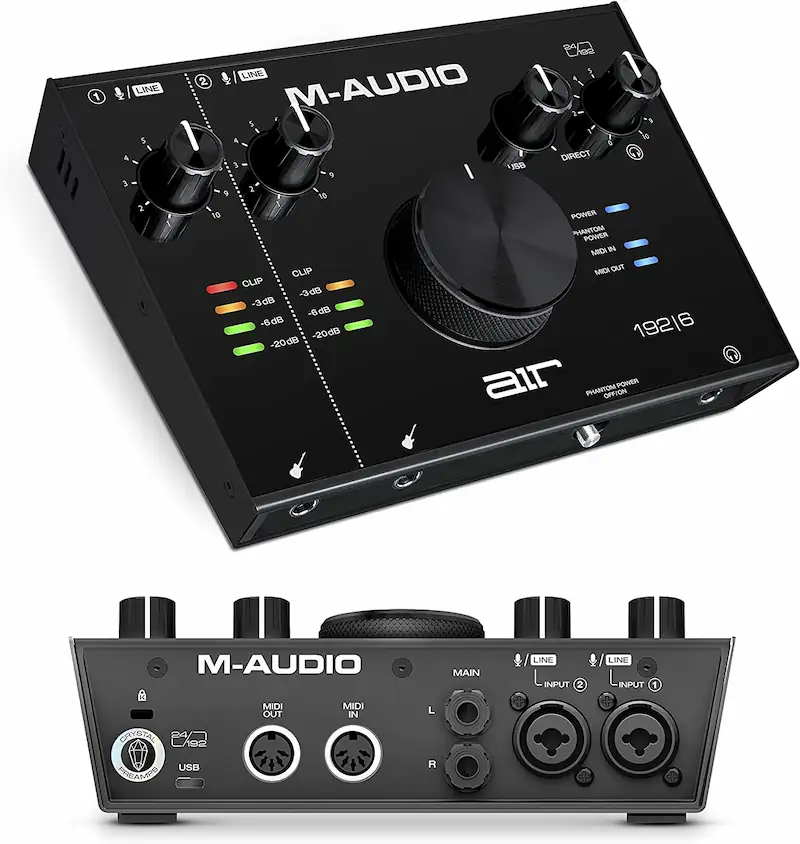The 10 Best Audio Interfaces For Logic Pro X
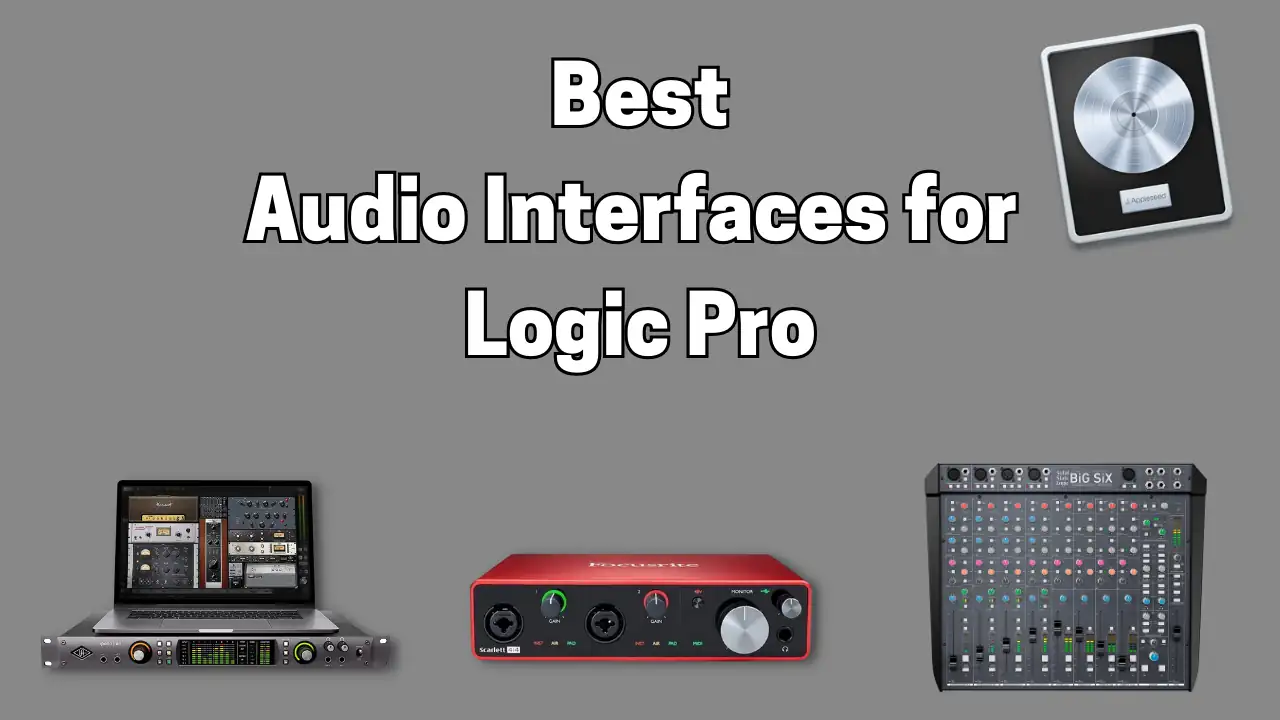
Are you sick of your tracks sounding like they were recorded through your old Nokia flip phone?
Luckily, you’ve come to the right place, as we’ve compiled a list of the 10 best audio interfaces for Logic Pro X.
It's time to upgrade from your makeshift recording studio in your mom's basement to a professional setup that'll get you closer to the quality of pro-level producers and engineers.
Note: this article may contain affiliate links, which mean that I receive a commission for any purchases you make, at no added cost to you.
Best Professional Audio Interface for Logic Pro X
Universal Audio Apollo x8p Thunderbolt
Shield your eyes from the blinding light as we unveil the Rolls Royce of audio interfaces — the Universal Audio Apollo x8p Thunderbolt. This is easily the best audio interface available for most home studios, though it may be more power than you need.
This beast of a device is one of the most powerful home studio interfaces on the market today.
The Apollo x8p rises above other home recording equipment as a premium interface designed for professionals who demand the best sound quality, flexibility, and ease of use.
It boasts eight mic preamps (each with a phantom power xlr input) two Hi-Z instrument inputs, two headphone outputs and 18x22 I/O, making it the perfect fit for any music producer or recording engineer who is serious about their craft. The cool thing about these 8 microphone preamps is that they use UAD's spectacular "Unison" technology, allowing you to model a host of classic preamps and effects of incredibly low latency.
Of course, what really sets this interface apart is the sheer amount of virtual knobs, buttons, and switches it delivers through the UAD virtual interface. Being able to control everything from your desktop is an absolute dream.
With the virtual interface, you can enjoy all of UAD’s high-quality plugins without the latency or CPU-bogging that you’d get using them as inserts in Logic.
Not to mention, the Apollo x8p is so visually stunning, it could pass as a modern art piece. It puts a lot of the old racks to shame with its deep grey, metallic chassis and bright LEDs.
If you want to take your Logic Pro X game to the next level, look no further than the Universal Audio Apollo x8p Thunderbolt. One note is that Windows Users probably won't have a great experience with the UAD interfaces - while there are some work arounds, I can only recommend using them with a Mac - but then again you can't really use Logic Pro on Windows, so it doesn't really mater.
SSL Big SiX
If you want to experience audio clarity like never before from a company that has a deep-rooted history in professional sound, look no further than the SSL Big SiX audio interface! This thing is a behemoth, so you’ll definitely need a bit of extra real estate for it, but your ears will thank you.
First off, you get the sleek and sexy design of old-school SSL consoles. It's a true audio supermodel without the drama.
The tactile design with the large, SSL-style big knobs and buttons makes the music production process feel like something straight out of NASA mission control.
And the sound quality? Yea, it’s incredible. The preamps are fantastic, as you’d expect from SSL, and you get up to a 96kHz sample rate for pristine audio.
The SSL Big SiX has eight mic preamps that can handle anything you throw at it, from an acoustic guitar to a drum set. Plus, the built-in compressor and EQs on each channel allow you to make changes on the fly.
The only downside is that the price tag is a little steep.
But hey, if you want the best of the best and the feeling of making an old-school record in your bedroom, you gotta pay for it.
Lynx Aurora(n) 16 Thunderbolt
If you’re in the market for an audio interface that will make your tracks sound as crisp as freshly washed lettuce, look no further than the Lynx Aurora(n) 16 Thunderbolt!
With 16 channels of analog I/O, you have more than enough space to record that Peart-style drum set you’ve always dreamt of. And with Thunderbolt connectivity, you can transfer your tracks faster than ever before.
But that's not all, kids, the Lynx Aurora(n) 16 Thunderbolt also features advanced control over your signal, so you can get the exact sound that you hear in the recording room without any signal degradation. The company has made a clear stance on how much pride it takes in transparency.
And if you're worried about compatibility, fear not! This interface is fully compatible with both iOS and Windows. There's also a Pro Tools version of this interface, but were talking about Logic here, so make sure you get the correct one!
With its 192kHz mastering grade conversion, audiophile-grade headphones ins and outs, and a road-ready chassis, the Lynx Aurora(n) 16 Thunderbolt is the audio interface you’ve been waiting for.
Best Audio Interfaces for Logic Pro for Small Home Studios
Universal Audio Apollo Twin X
The Universal Audio Apollo Twin X has gained a reputation as the ultimate savior of small home studios everywhere. This pint-sized powerhouse packs a serious punch, providing crystal-clear sound that'll make you think you're recording in a professional studio rather than your dorm room, making it my favorite interface at this price point.
And, as with most of UAD’s gear, The Apollo Twin X is so intuitive and user-friendly that even your grandma could use it (if she's ready to lay down some sick beats, we’re ready to hear ‘em!)
On top of that, its sleek design and compact size won't take up too much space on your already-cluttered desk.
But don't let its small size fool you – this little guy can play with the big boys. With its built-in UAD-2 SOLO or DUO Core processor, you can load up all the plugins you need without worrying about overloading your computer. And with 2 Unison preamps, you can capture your vocals or guitar with unmatched clarity and warmth. Essentially, you get the sound of the Apollo x8 Thunderbolt in a smaller package, including the incredible bundled software.
Whether you're a budding musician looking to make your first album or an on-the-road producer looking to make some fiery tunes throughout your travels, the Universal Audio Apollo Twin X is the perfect choice.
Universal Audio Apollo Solo
If you want to take your home studio game to the next level without breaking the bank, and the Apollo Twin X is just outside your budget, then look no further than the Universal Audio Apollo Solo. Its combination of high-quality sound, plug-in bundle and key features makes it the best value in its price range. After trying a lot of different options, this is the interface that I use in my home studio.
This miniature powerhouse is perfect for small home studios and budget-conscious music producers who want to upgrade their audio quality. With its Unison preamp technology and real-time UAD processing, the Apollo Solo provides a level of clarity and depth to your recordings that are nothing shy of professional. You can easily get professional quality home recordings with this beauty.
In terms of connectivity, the Apollo Solo includes a Hi-Z instrument input (for an electric guitar or bass), and a stereo output for your monitors. It also has an optical input that allows for expansion with up to eight additional channels of digital input if you need to expand. If you're not just a guitar player, you also have access to two mic/line inputs with phantom power so that you can use it with a condenser microphone. Although it would seem like there are three slots for an input signal (Hi-Z + the mic/line input), the active number of inputs you can record with at anytime is only two.
And, as you’d expect, you get the same sleek and stylish design that you get with any other UAD interface.
The Solo will look great on any desk, and its compact size means you can take it with you wherever you go. I’ve used it on so many rogue recording sessions, and it’s absolutely fantastic.
Whether you're recording in your friend's basement or a cabin in the woods, the Apollo Solo is a legendary little device.
You can read my full review of of this incredible thunderbolt interface here.
Apogee Symphony Desktop
Another solid premium audio interface that won't break the bank is the Apogee Symphony Desktop! This little guy packs a big punch, giving you all the high-end features you need to take your Logic Pro X recordings to the next level.
The first thing you’ll notice is the design. Similar to the UAD Apollo devices, the Apogee Symphony Desktop is sleek and stylish, with a silver matte finish and that “plucked straight from a sci-fi movie” look.
Of course, recording isn’t about aesthetics, so luckily, this thing means business. With a 10-in, 14-out configuration, you'll have all the I/O you need to capture every nuance of your performance.
And speaking of performance, the Apogee Symphony Desktop delivers the goods. Its flagship AD/DA conversion technology ensures that your recordings sound pristine, while the onboard DSP lets you add all kinds of effects and processing without putting too much strain on your computer's CPU.
Plus, with compatibility for both Mac and Windows, you won't have to worry about switching to a new setup if you decide to switch platforms.
Overall, the Apogee Symphony Desktop is the perfect choice for small home studio folks who want portability and flexibility.
MOTU UltraLite-mk5
The MOTU UltraLite-mk5 is the fifth iteration of an already impressive lineup.
This bad boy is loaded with innovative elements, from the audiophile-grade ESS Sabre32 DACs to the decoupled outputs that ensure your music stays crystal clear and free from pesky noise.
Of course, there’s more to it than sonic superiority.
This baby also comes with all the IOs you need to turn your small home studio into a professional recording space, including USB-C, TOSLINK/ADAT I/O, and S/PDIF IO.
And let's not forget the ten balanced TRS line outputs, six balanced TRS inputs, and MIDI inputs and outputs for your midi keyboards. With this level of IO, you’d expect the price to be higher. Especially since it doubles as a MIDI interface. There are also a pair of mic/line inputs on the front, each with its own dedicated gain control.
If you're worried about your signal coming in too hot, fear not. The UltraLite-mk5 comes with a -20dB pad to keep everything under control. Plus, the new OLED screen is a true thing of beauty, making you feel like a bona fide studio pro.
Sure, the CueMix 5 software isn't exactly the most beloved, but with virtual instruments and 6GB of free loops and samples, you'll be too busy making beats to care what someone on Reddit says.
Best Budget Audio Interfaces for Logic Pro X
Universal Audio Volt 1
Once upon a time, Universal Audio was all about those high-end interfaces, making home studio enthusiasts feel like true fancy-pants audio engineers.
But then something shocking happened — the introduction of the Volt 1.
While the Volt range may have left the plugin hosting at home, they make up for it in standard features and value.
For starters, you’ll find UA's signature preamps on the Volt’s combi inputs, which sound great.
Note that there are two iterations of the Volt — The Volt 1, which has one input, and the Volt 2, which has two, so choose your weapon.
Either way, you get that vintage tube sound that'll make your recordings sound like they were made in the 60s, baby.
These plug-and-play USB-C interfaces are a radical departure for UA, and they're not compatible with plugins from the UAD store. However, with all the money you save on the interface, you’ll have some left over to buy your own third-party plugins!
Overall, if you're looking for an interface that won't break the bank but still makes you feel like a legit audio pro, the Volt 1 has got you covered.
Focusrite Scarlett 4i4
If you’re not thoroughly impressed by the third-generation Scarlett USB interfaces from Focusrite, you have no soul! An earlier version of the the 4i4 was my first audio interface, and this thing continues to include everything a beginner needs.
Not only do these budget-friendly interfaces have improved preamps with up to 56dB gain (more gain than your gym rat buddies), but they've also got balanced connectivity throughout and even come with Focusrite's ISA transformer preamp emulation option, which they so cleverly call "Air.”
This interface is the perfect example of this affordable quality, offering two mic/line/instrument inputs with gain, four TRS outputs, and two line-level TRS inputs. And let's not forget about the software - the Scarlett Control app allows for low-latency monitoring and offers some settings that can only be made in the software. If you’re into the tactile feel, this quirk might be slightly annoying.
Once you've got your budget interface, you can also check out these five affordable instruments that you can use to improve the quality of your home recordings.
As for the overall sonic quality, it’s as neutral as Switzerland, though sweeter than their chocolate. Luckily, if you're looking for a little spice, the Air option can give your recordings that expensive high-frequency lift.
Plus, you get a decent software bundle included, making this upgrade a no-brainer.
If you need a solid, wallet-friendly recording setup, check out the 3rd gen Scarlett USB 4i4 3rd.
M-Audio Air 192
Don't be fooled by the price tag, this little interface is a real gem! M-Audio has long been known for its budget-friendly hardware, and the M-Audio Air 192 holds up.
With top-notch preamps for the price, you can get clear vocals recordings from the comfort of your own bedroom.
We can’t go without talking about the simple, user-friendly layout. With two XLR/TRS combos, two TRS inputs, two TRS outs, and MIDI I/O, you'll be able to connect more gear than you ever thought possible for the price.
If you're serious about making music and don't want to break the bank, M-Audio Air 6 is the perfect entry-level option.
Important features in Shopping for an Audio Interface
Number & Type of Inputs
The first thing you want to consider when buying an audio interface is the number and type of input.
Do you want to keep it intimate with just a few (two to four) inputs or record the full band with somewhere along the lines of 8-16? Make sure to look at the type too, such as instrument or XLR.
Number & Type of Outputs
The number and type of outputs are like the limbs on your musical body.
You don't want to be a one-legged mono trying to conquer the high seas of music production. Consider what kind of outputs you need, such as TRS outs to connect multiple monitors or MIDI outs to control other musical devices.
Mic Preamps
The right mic preamps can make all the difference in the world.
Do you want your recordings to sound pure honey or have a bit of color?
And how much noise can you stand? For me, I want a preamp that's as quiet as possible.
Number of Headphone Jacks
If you’re recording alone, one headphone jack should suffice. However, if you’re planning on recording with the whole band, you’ll need a multi-out.
Connectivity
Don’t get stuck with an old-school USB interface. We’ve moved passed that and into the Thunderbolt age. Thunderbolt is so much faster.
Number of Phantom Power Channels
If you’re recording with high-quality condenser mics, you’ll need phantom power channels. The question is, how many? Consider the kinds of mics you use and what you might need in terms of recording.
DA Converters
DA converters turn digital signals into beautiful analog soundscapes. You want DA converters that bring your digital sounds to life with crystal-clear clarity, magical warmth, and high resolution. Don’t settle for anything less.
Latency
Latency sucks. You might need an interface that can keep up, both in terms of recording and monitoring. Look for low-latency interfaces that you can record and playback with, even when you’re working with hundred-track sessions.
Other Resources for Logic Pro
If you're looking to go even deeper and perfect your Logic Pro setup, be sure to also check out these articles!
- The 34 Best Free & Paid VST Plugins for Logic Pro X
- The 10 Best Audio Interfaces For Logic Pro X
- The 20 Best Free & Paid Vocal Plugins for Logic Pro
- 18 Best Free & Paid Drum Plugins for Logic Pro X
- The 13 Best Control Surfaces for Logic Pro
- The 10 Best Audio Interfaces for Logic Pro
- The 10 best MIDI Controllers for Logic Pro
From a Frustrated Producer in a Ragtag Bedroom Studio to Major Placements on TV Earning $1,000s!
My name is Evan, and I've been making music since around 3rd grade. I'm from San Diego, California, but I've lived in Washington, DC for the last 20 years.
While I still have a full-time day job, I have created systems that have allowed me to produce dozens of songs a year in my spare time.
My songs have been on Netflix, TV shows like the 90 Day Fiance, an award-winning indie film, and NPR’s “All Thing Considered.” They've also been streamed millions of times.
In addition to being a music producer, I am passionate about teaching people how they can make professional-sounding music and earn money licensing it, all in their spare time.
Thousands of musicians, like yourself, have trusted me to guide their musical journey. My YouTube videos have been watched nearly a million times. And my story has been in Forbes, Side Hustle Nation, and the Side Hustle School.
